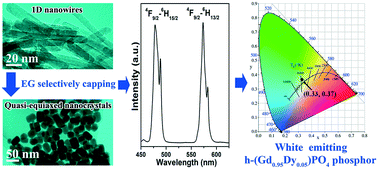Breaking the strong 1D growth habit to yield quasi-equiaxed REPO4 nanocrystals (RE = La–Dy) via solvothermal reaction and investigation of photoluminescence†
Abstract
Quasi-equiaxed REPO4 (RE = La–Dy) nanocrystals of either monoclinic (m-) or hexagonal (h-) structure, depending on the type of RE3+, have been successfully synthesized through solvothermal reaction in the presence of ethylene glycol (EG). Detailed characterization of the products was achieved by the combined XRD, FE-SEM, TEM, FTIR, TG/DTA, PLE/PL, and fluorescence decay techniques. The intrinsically strong 1D growth of the phosphates was gradually suppressed through increasing the solution pH and EG dosage, and the formation mechanism was elucidated with h-GdPO4 as a representative. The differences in the crystal structure, IR response and crystal size of the as-synthesized REPO4 crystals were interpreted in detail. It was shown that the phase purity and crystal morphology of h-GdPO4 can be well retained up to 700 °C, followed by a complete transition from the hexagonal to monoclinic phase at 900 °C. The photoluminescence properties of Dy3+-doped h-GdPO4 nanocrystals, including excitation, emission and fluorescence decay, were thoroughly investigated, and almost pure white-light luminescence was attained with similarly strong yellow (573 nm, 4F9/2 → 6H13/2) and blue (478 nm, 4F9/2 → 6H15/2) emissions of Dy3+ under excitation of the host Gd3+ ions at ∼274 nm.



 Please wait while we load your content...
Please wait while we load your content...